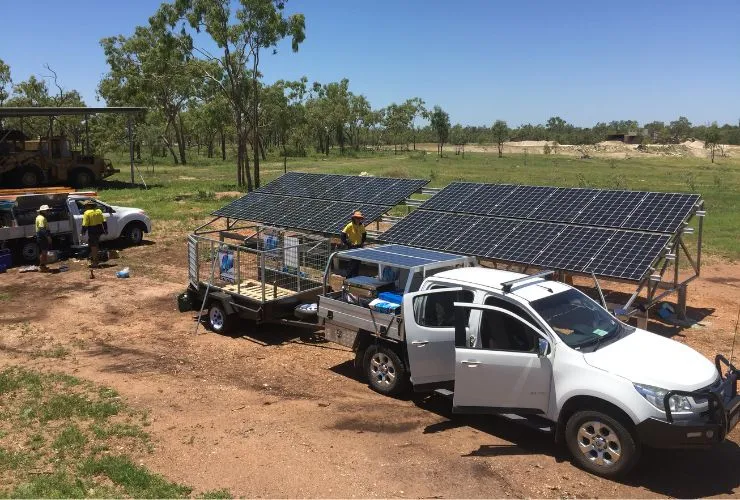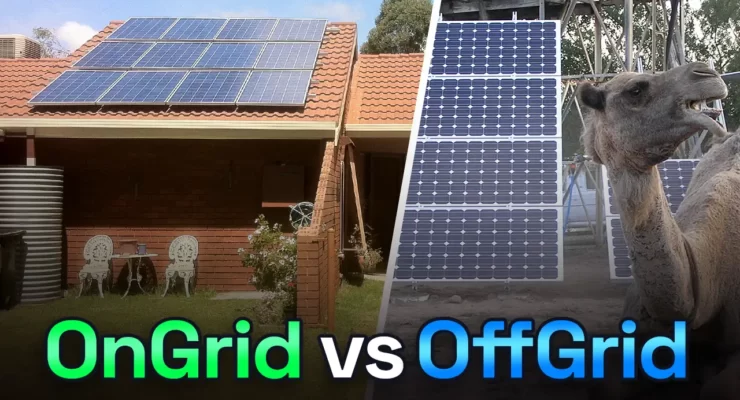Fast read
On-grid solar systems are installed on properties connected to the main electricity grid. They utilise solar energy primarily for on-site consumption, with excess power sent back to the grid or stored in batteries if available. During low solar production, electricity can be drawn from the grid and paid for through an energy retailer, providing flexibility and security.
Off-grid solar systems are independent installations without access to the grid. They supply all electrical needs through solar panels, batteries, and occasionally backup generators for extreme circumstances. Planning an off-grid system requires a thorough assessment of energy usage, ensuring it can handle peak demands and sustain power during inclement weather.
Due to the need for autonomy, off-grid solar systems are costlier and more commonly installed in remote areas where grid connections are impractical. Efficient energy management is vital for successful off-grid living.
What is the difference between on-grid and off-grid solar?
On-grid solar
An on-grid solar system is installed on a property connected to the main electricity grid. This type of system harnesses energy from the sun using solar panels, converting sunlight into electricity through photovoltaic cells. When the solar panels produce solar power, it is first used within the house to meet the immediate energy needs of the occupants. This means that appliances and devices running in the home during daylight hours are powered directly by solar-generated electricity. Reducing the reliance on grid-supplied power and lowering electricity bills.
If the electricity generated by the solar panels exceeds the current demand of the house, the excess energy has several possible paths. One option is to charge a battery storage system if the property has one installed. Batteries can store the excess solar energy for later use. Such as during the evening or on cloudy days when solar production is reduced. This enables homeowners to further optimise their energy usage and reduce reliance on the grid, increasing self-consumption of solar energy and enhancing energy independence.
If the battery is fully charged or if there is no battery storage system in place, the surplus electricity goes back to the main electricity grid. A bi-directional meter handles this process, tracking both the electricity consumed from and supplied to the grid.
When homeowners export solar energy back to the grid, they often get credits or compensation for the excess electricity produced. This depends on the local regulations and utility policies. It’s called net metering, where the electricity meter effectively spins backwards when exporting power, offsetting the homeowner’s electricity costs.
What happens when the solar system does not produce electricity?
During periods when the solar electrical system is not producing electricity or enough electricity, and there is no battery available, then power can be drawn and used from the electricity grid. This drawn electricity will be paid for through your energy retailer. This is the option that most people have when they install solar. It allows them to use their electricity from solar panels when available and have the flexibility and security to have power from the electricity grid when needed.
So, what are the differences between the two solar systems?
- Grid Connection: Off-grid systems operate independently of the grid, while on-grid systems are connected.
- Battery Storage: Off-grid systems require storage to store excess energy when solar production is low. At the same time, on-grid systems typically do not include batteries (although battery storage can be added for backup power or energy storage purposes).
- Reliability: Off-grid systems rely solely on stored energy and may experience power shortages during high-demand or low-solar production periods. On-grid systems provide a more reliable electricity supply since they can draw electricity from the grid whenever needed.
- Cost: On-grid systems are generally less expensive than off-grid systems because they do not require expensive battery storage solutions.
- Grid Interaction: On-grid systems can export excess energy to the grid, potentially earning credits or income through net metering or feed-in tariffs. In contrast, off-grid systems do not interact with the grid this way.
Off-grid solar
An off-grid solar system is an installation installed on a property that does not have a connection to the electricity grid. The solar system provides for all the property’s electrical needs. As well as solar panels and batteries, this will usually include a petrol or similar generator. The generator provides electricity in extreme circumstances when the solar and battery may run out.

Installing off-grid solar
Off-grid solar systems are completely self-sufficient. As a result, there is a significant amount of complexity in planning and installing the system to ensure it is fit for purpose.
A full assessment must determine which appliances will be used in the home when they will be used, how long they will run, and which appliances and electrical loads will run at the same time.
With the system being designed for several days of autonomy without sun, the cost of an off-grid solar system is far more expensive than what would be required for an on-grid system. They also require more care and consideration in using electricity to conserve and manage the solar system. However, there are STCs that you can claim through the government to help make an off-grid system more affordable.
Off-grid solar systems are usually installed in remote areas where it is too expensive to connect to the main electrical grid.
In Summary
In conclusion, both solar systems have their own pros and cons. On-grid solar systems are connected to the regular electricity grid. They’re usually cheaper and let homeowners use grid power when needed. They don’t usually have batteries, but you can add them later for backup power.
Off-grid solar systems work without the grid. They’re great for remote areas where connecting to the grid is hard or costly. These systems need careful planning and are more expensive upfront. They can be totally self-sufficient but might need a generator as a backup.
So, the choice between the two solar systems depends on where you live, your budget, and how much energy you use. Both options help you use clean energy and can save you money in the long run.



